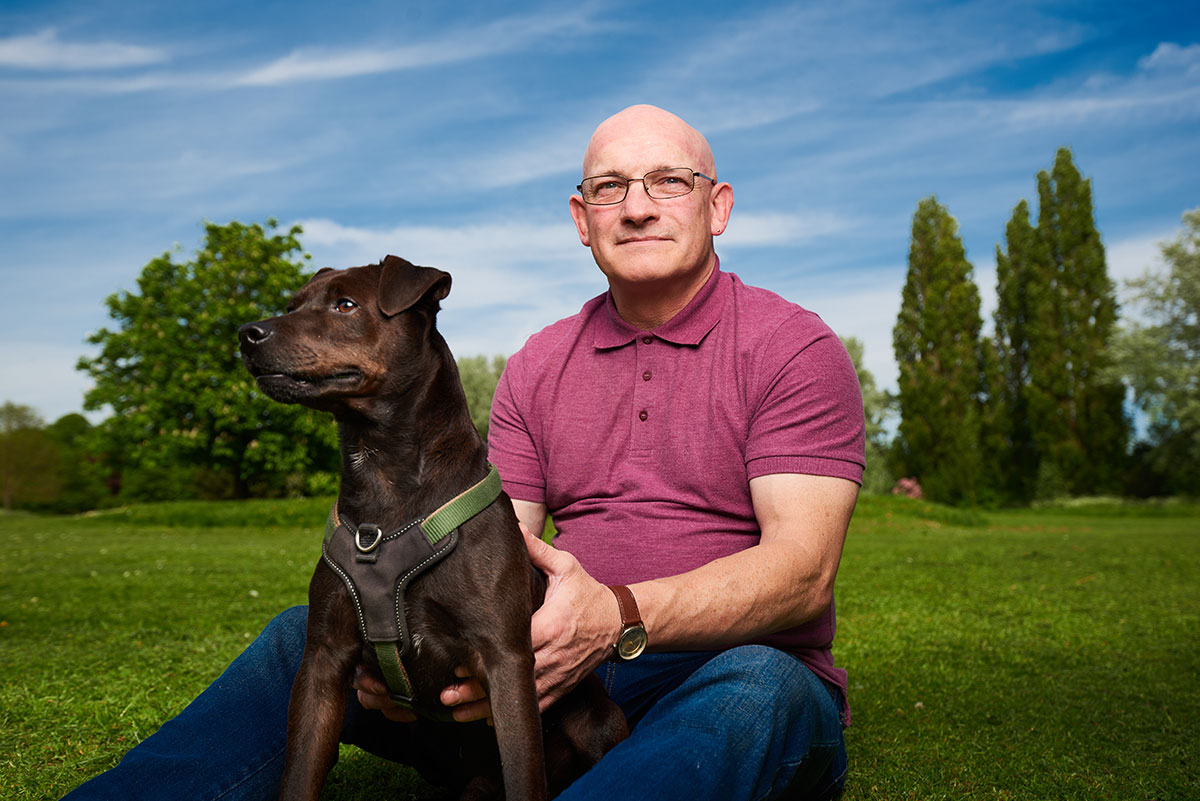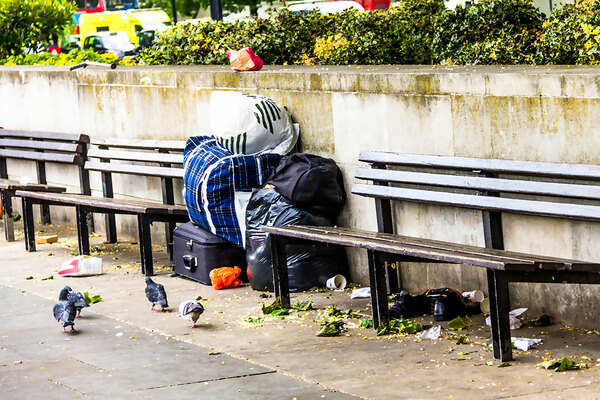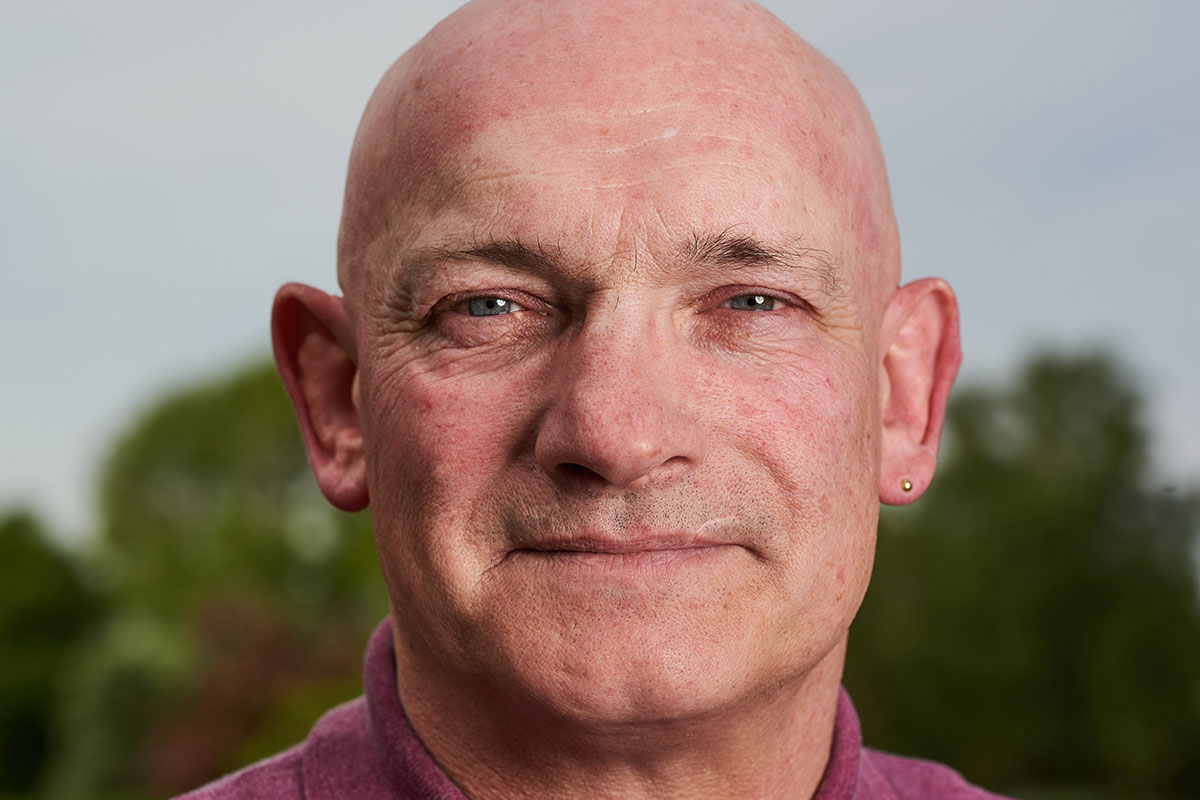You are viewing 1 of your 1 free articles
Trauma and homelessness – how services need to change
If you’re homeless, accessing support and housing can be difficult, even traumatising. But two new approaches aim to change that, by training staff to better understand what service users have been through. Lauren Crosby Medlicott reports. Photography by Simon Brandon
Lawrence McDonnell never expected to end up sleeping on the streets of London, but a horrific experience as a victim of modern slavery in 2007 led to his world caving in. He was homeless from 2011 to 2014, and he found himself drinking copious amounts of alcohol to cope with his memories, attempting to drown his feelings of hopelessness.
“How they were talking to me was the way that my abductors talked to me”
“I was suicidal,” the now 56-year-old tells Inside Housing. “I was just fed up of waking up every morning.”
Mr McDonnell’s first attempt at getting off the streets left him in total despair. He had gone in to the council offices, with letters acknowledging what he had been through, to attempt to get his old council flat back.
“They asked me what I wanted them to do about it,” he says. “They told me I’d have to join the queue again for the housing list, but they doubted I would get [a flat], because I had given the property up. They made me feel like it was all my fault. I just couldn’t understand how they couldn’t understand or believe what I was saying.”
That first interaction with a homelessness team triggered Mr McDonnell’s ‘fight or flight’ response. “How they were talking to me was the way that my abductors talked to me,” Mr McDonnell remembers. He responded defensively, shouting and swearing, and was thrown out of the office.
“The whole system is just robotic,” Mr McDonnell says, describing his experience of presenting as homeless. “There is no understanding, or even a desire, to understand.”
The trauma-homelessness connection
Joanne Prestidge, head of national practice development at Homeless Link, a charity for homelessness service providers, tells Inside Housing: “Homelessness itself can be traumatic, but quite often people have experienced other adversity which may have led them to be in need of support and housing. Homelessness and housing services will often be supporting individuals whose homelessness, or risk of homelessness, is a symptom or result of other support needs or difficulties they’ve experienced.”
“If we are getting somebody off the street or moving them into a different property within a required time limit, staff may focus more on the perceived need to fill out a form rather than on the individual before them. Rather than perceiving behaviours as a mechanism to cope with a challenging set of circumstances, the focus is often on what is ‘wrong’ with the person”
Yet many homelessness and housing support services are not trained to respond appropriately to provide the best care for these vulnerable individuals.
“Typically, homelessness services will be process and rule-driven,” Benn Kiley, operations manager at A2Dominion, the 38,000-home housing association, explains. “If we are getting somebody off the street or moving them into a different property within a required time limit, staff may focus more on the perceived need to fill out a form rather than on the individual before them. Rather than perceiving behaviours as a mechanism to cope with a challenging set of circumstances, the focus is often on what is ‘wrong’ with the person.”
The ‘get it done’ mentality within housing can leave service users feeling isolated, ashamed, disempowered, defensive, retraumatised, or inappropriately housed.
“Too often, and unintentionally, the way services are designed and delivered can replicate some of the dynamics experienced in traumatising situations. Being aware of this and working differently mean we can reduce the likelihood of embedding people’s trauma”
“It all creates an imbalance of power within the support worker relationship – there is no trust in place,” says Mr Kiley. Without trust, a service user is likely to feel unsafe, triggering a fight or flight response that will make it more difficult to meet their housing needs.
To increase feelings of power and control, service users experiencing homelessness may turn to drugs, alcohol or anti-social behaviour, all coping mechanisms that could lead to further housing problems. “The individual is evicted, often to the street, labelled as ‘difficult’ and banned from services,” says Mr Kiley.
In 2014, Mr McDonnell went into hospital with pneumonia. Before being discharged, someone from the Single Homeless Project came to see him and, for the first time, he felt like he was being supported by people who really cared about his well-being.
“It’s the way they talked to me,” he says. “I could feel the genuine empathy and realness in their voices.”
They assured Mr McDonnell he wouldn’t go back onto the streets when he left hospital. “It was the first time I had ever cried,” he says through tears. Eight years later, Mr McDonnell is sober, living in a housing association flat, working as a handyman and volunteering for the Single Homeless Project.
“Trauma is the reaction to events in which people are fearful for themselves or significant others, and in which they experience a loss of control,” Ms Prestidge says. “Too often, and unintentionally, the way services are designed and delivered can replicate some of the dynamics experienced in traumatising situations. Being aware of this and working differently mean we can reduce the likelihood of embedding people’s trauma.”
Domestic abuse was the cause of nearly one in six new homelessness cases in England between April and June 2021: 5,590 families had no home to call their own after fleeing an abusive partner. Numbers rose again between July and September 2021, with one in five households made homeless as a result of domestic abuse.
For people (mostly women) presenting as homeless following escape from an abusive partner, it is vital for their safety and well-being that homelessness and housing staff are attuned to their needs.
“When I asked women in a refuge setting to describe their overall experience of presenting as homeless because of domestic abuse, they told me they felt like a burden, a statistic, not a person and not taken seriously,” says Kelly Henderson, managing director of Addressing Domestic Abuse, a social enterprise that equips housing providers and associated supply chains to recognise domestic abuse so that residents can be assured of a positive response.
“Some said they experienced no empathy, were made to feel worthless and embarrassed, and that staff were snappy with them. One woman said she felt let down and unsafe.”
After leaving an abusive partner, these kinds of feelings are reminders of the abuse they escaped – powerlessness and lack of control.
A homelessness officer will often ask victims to recount why they are presenting as homeless, rehashing everything the person has suffered.
“The whole process can be re-traumatising,” says Ms Henderson.
“I’d be there first thing in the morning for two weeks. I would be in there for hours, and then they would ask me to come back. It was such a long, hard process and made me even more stressed than I already was”
Rebecca* (not her real name) had been a victim of domestic abuse in two relationships when she found herself living on the streets of London in 2016. Despite multiple police reports and A&E records proving her history, homelessness services placed her in temporary hostels and night shelters surrounded by men, drugs and alcohol, rather than a refuge for women. She says she felt dismissed as just another drunk.
“The night shelters and hostels were worse than being on the streets for me,” Rebecca remembers, describing her feelings of fear and vulnerability amid dozens of men using drugs and alcohol. “But I just started to think it was what I deserved.”
Near the end of 2020, Rebecca was fed up with constantly feeling at risk of attack on the streets and went to the council to try and sort her housing. “They were useless,” she says. “I’d be there first thing in the morning for two weeks. I would be in there for hours, and then they would ask me to come back. There was one time they said I was going to be put somewhere, and then the lady that was dealing with me just went off ill. It was such a long, hard process and made me even more stressed than I already was.”
Finally, in December 2020, Rebecca was offered support by Athena, a Refuge-run service supporting women experiencing domestic violence, which helped her get placed in a refuge run by Next Chapter.
“I was an emotional wreck when I arrived at the refuge, because I couldn’t believe how it felt to be safe,” Rebecca says.
If Rebecca had received trauma-informed support from homelessness teams from the beginning, she could have avoided years on the streets and inappropriate emergency accommodation.
“I walked into my room and finally knew it was over,” Rebecca says, recalling the start of her healing process at Next Chapter. “I haven’t looked back since.”
The importance of training
Better training could help prevent homelessness services piling harm onto vulnerable individuals.
Psychologically informed environments (PIE) and trauma-informed care (TIC) are two responses services that can be adopted. The intention of both is to improve the psychological and emotional well-being of people accessing the service, as well as those providing it.
Ms Prestidge from Homeless Link says: “These approaches put trust, transparency and a balance of power at the forefront of the work, as opposed to that work being driven by standard processes.”
Staff training is the first step for an organisation, “though there can be some pitfalls with this”, Ms Prestidge says. “In the past, organisations have only trained their frontline support staff, where in fact you would want as many people at all levels in the organisation to have training. Or they may think that training is the only thing that needs to happen in order to be trauma-informed. It really isn’t that simple.
“To implement these approaches, organisations need to ideally commit to trauma-informing their whole ‘system’ so that it is embedded at all levels.”
“We completely changed our approach and language”
“When I started in my role, I knew we needed something to focus our thinking on how we put the human first,” says Jason Smith, head of care and support at Caredig, the Swansea-based housing association. “Continuing on as we were wasn’t an option. We ultimately chose PIE.”
Mr Smith describes PIE as a journey his team went on to learn more about trauma and adverse childhood experiences (ACEs) and then use that understanding to inform how they work.
“PIE doesn’t tell you what to do as an organisation,” Mr Smith emphasises. “It’s a framework.”
Staff members were trained to focus on the human being accessing their service, taking into account their trauma, ACEs and what they want.
“Because we’ve spent more time finding out about the people we support, we can understand better how to approach the situation. It may be more support, a restorative approach with other tenants/staff, or a simple warning. What is important is that we don’t jump to a specific conclusion. We will work with the individual and support them in a way that will work for them,” Mr Smith says.
The initial risk assessment process also changed. “We saw that it can re-traumatise people,” Mr Smith says. Staff would have asked questions such as, “When was the last time you were abused?” or, “When was the last time you self-harmed?”
“We completely changed our approach and language,” Mr Smith explains. “Now we fully involve the people we are supporting. We focus on two areas: how they can keep physically safe and psychologically well. We call it a keeping safe and well conversation. One service user said it was the first time he’d really been listened to and been free to choose what he wanted to do.”
At the heart of PIE or TIC is empathy, instead of judgement, as a means of building trust. “Our emphasis is on the quality of the relationship, underpinned by a belief that every individual strives toward what is good,” says Mr Kiley, who has been involved in rolling out PIE at A2Dominion. “Put simply, it is about increasing the understanding of what makes people do the things they do and building services around that.”
Sign up for the IH long read bulletin
Already have an account? Click here to manage your newsletters













